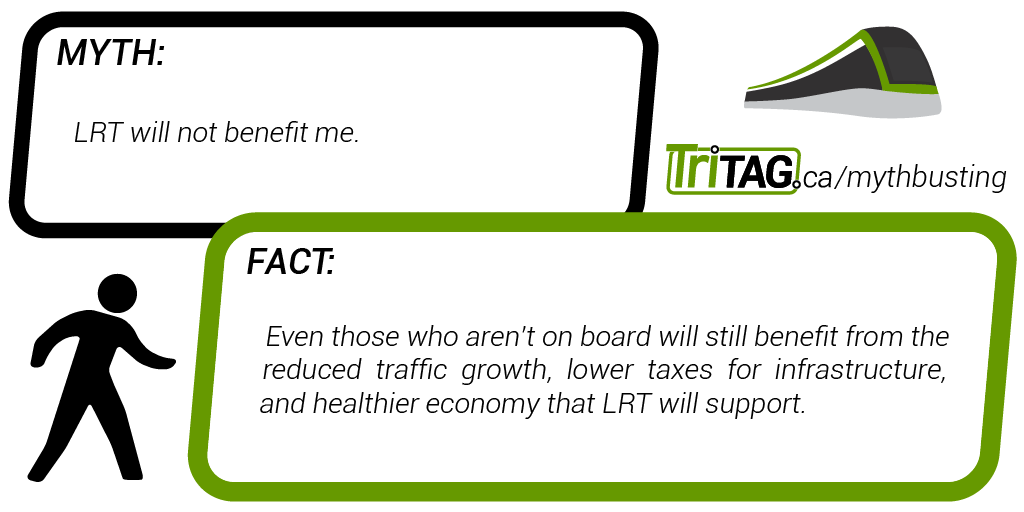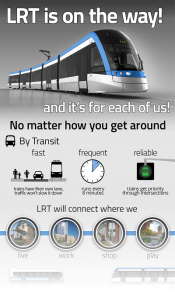Over the years, we’ve spoken with citizens all across Waterloo Region about LRT, and we’ve come across both ardent supporters and resolved opponents. But most people have approached the creation of rapid transit with an open mind, often with a healthy dose of skepticism. They’re not sure what’s in store.
When regional council approved LRT in 2011, they made the decision with the future in mind. They chose it over a bus-based system despite the fact it cost a little more, because it also provided more long-term value. We’ve spent enough time talking about how senseless it would be to bail out now that we’ve spent that money. Today, we need to focus on why we’ve embarked on this path in the first place.
Let’s talk about the value that ION light rail transit will bring you.
[youtube http://youtu.be/wj6NQfe-9do]
If you live or work along the line, the benefit of ION is obvious. High quality, comfortable transit offers thousands the opportunity to reduce their transportation expenses. ION’s capacity and reliability means that the Region can rebuild its entire transit network around it. Many thousands of people live along the corridors that have already seen, or will shortly see new iXpress bus routes that are designed to integrate with ION to provide strong transit links region-wide. Perhaps one such route will benefit you.
Providing transportation alternatives is a major part of our community’s strategy to become a more livable, affordable place. So too is directing new growth towards the core of our community. And light rail is a vital part of this plan.
If your home or place of work aren’t along ION or iXpress, or your trip is still too awkward by transit, or if your life circumstances mean that you simply have to drive, then it’s harder to see ION as being worthwhile. But it will still be there, working for you:
- On the road, by reducing congestion from traffic growth,
- Where you live, by saving mature neighbourhoods from wider and busier roads,
- In the countryside, by protecting and preserving Waterloo Region’s farmland,
- Where you work, by supporting the healthy growth of our region’s economy,
- In your taxes, by reducing sprawl-driven infrastructure spending.
Not too shabby for something quickly dismissed by critics as a “mall to mall train”. We hope you’ll keep the bigger picture in mind when you vote on October 27th.
So ends our week of mythbusting the election. We wanted to wrap it up by busting the biggest myth of all: that LRT won’t benefit you. Because even if you have no use for it today, tomorrow could be a very different story. And that is what ION is about: the future. Come take a ride with us, and let’s see what tomorrow has in store.
- Mythbusting the election: Candidates said it, but can they back it up?
- TriTAG Election Candidate Survey: Find out where candidates stand on ION and transit!
- ION’s route, animated: Think it’s just a mall to mall train? Think again.
- ION Infographic: Find out the facts about ION, and how it will benefit you.



Will ION truly reduce traffic congestion, though? My understanding was that while it is to help encourage new people moving to the region to choose to live closer to the corridor and use ION and thus help *mitigate* *increased* congestion, it wasn’t really trying to get current region drivers out of their vehicles, in to transit and thus *reduce* *current* congestion.
Please explain the farmland point. A transit system in the city benefits the farmers how?
What about the eastern and western boarders of both Kitchener and Waterloo?
What about the townships sucked into paying for a service they won’t use?
Who is going to pay when the budget is blown and the entire project costs twice as much as originally thought?
Jo,
I’ll address your comments point by point.
1. Farmland: This column, written by the VP of Waterloo Federation of Agriculture, nicely covers the benefit to our rural community by building rapid transit in our urban area. http://www.therecord.com/opinion-story/4940167-farmers-have-a-vested-interest-in-light-rail-transit-project/
2. Eastern and western borders: We can expect sprawl expansion in all directions, and LRT is the foundation of a new transit system not just to shift people out of cars, but to shift development to the cores, and reduce outward expansion pressure in all directions. This ties into #1. As for citizens living east and west of the central corridor, LRT will underpin a network of new iXpress lines that are already being rolled out. You can see a map of that network and how it ties into the LRT “spine” here: http://rideion.ca/route-map.html
3. Township taxes do not include a charge for transit service they do not receive, and that includes ION construction and operation. A small charge for Woolwich for GRT bus service to Elmira and St Jacobs is the exception.
4. If the project sees cost overruns, the project consortium is responsible for paying for them. They will also pay penalties for delays and for failure to provide adequate service. That is a major reason for the “public-private partnership” (PPP) model of construction. Grandlinq is a private consortium of businesses who have signed a contract that sees them take on cost risk, and will therefore be highly motivated to stay on budget. This protects the regional taxpayer.